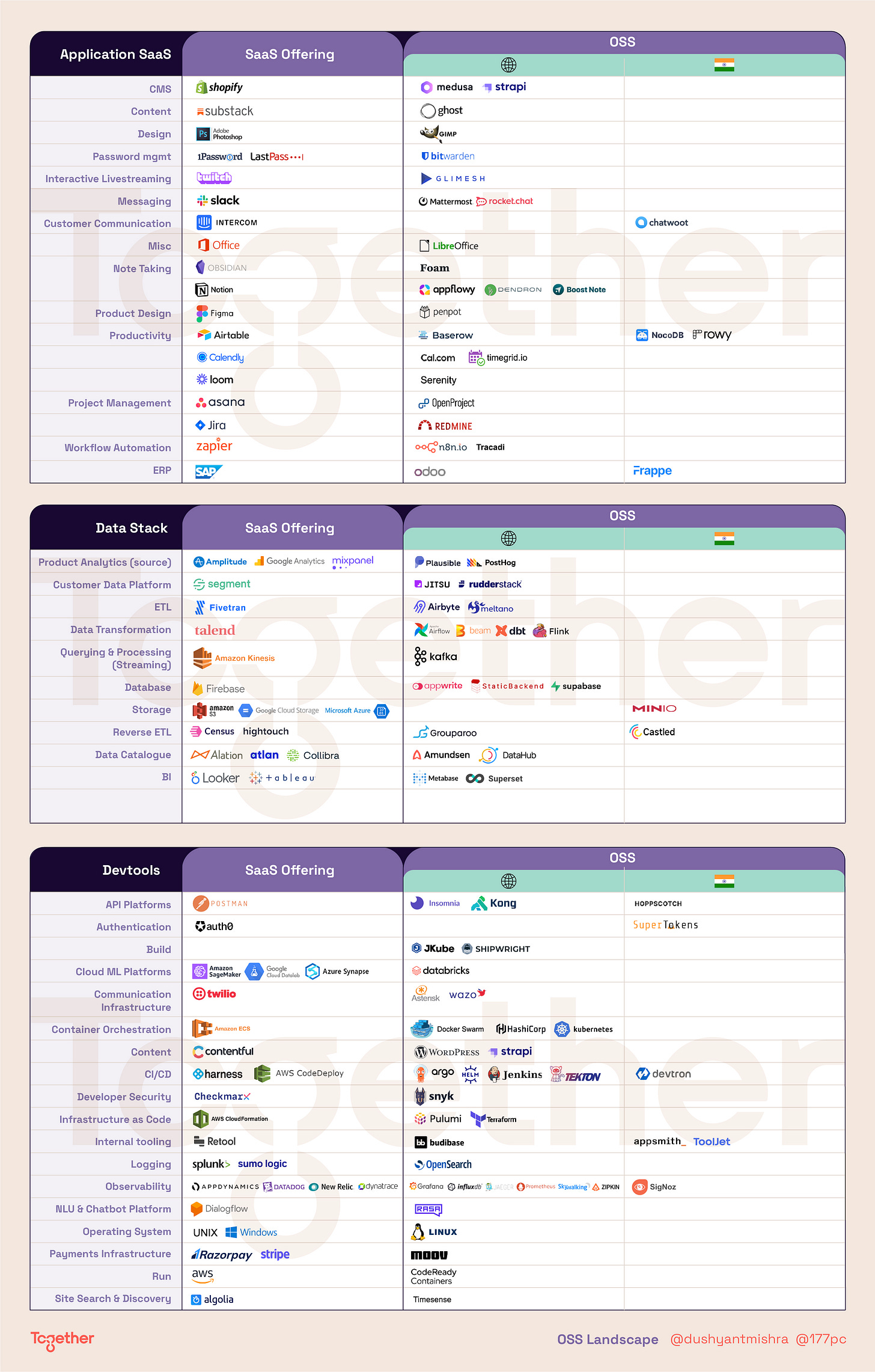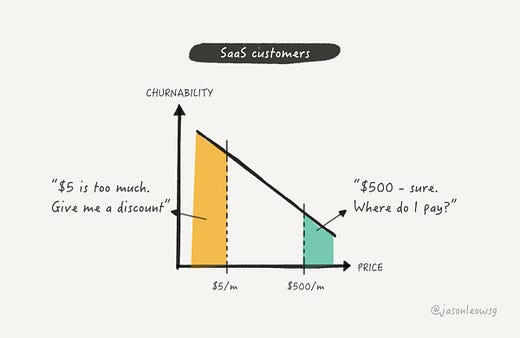Magic Of Open Source 🎩
Hello there. This is a monthly newsletter from Together. Our aim is to help entrepreneurs and founders realise their potential.
What can we promise you from this newsletter?
It will be fun and smart.
It will not take too much of your time. We know you have a lot to do.
This is the last in our series of GTM for early-stage companies. If this is the first time you’re reading our newsletter, we suggest you run through our back catalogue. There are some interesting guests there.
How do you build an Open Source business? 🚀
Open source businesses have been operating out of the mainstream. And RedHat has been the most popular example of a large open-source business with scale. But most people not plugged into the world run out of names fairly quickly. However, a large part of the internet is built on OSS. And we are not just talking about the Linux nerds here. Firefox gave us a smart and fast way of accessing the internet. It broke the monopoly of Internet Explorer (RIP!). But as a business, OSS has always been difficult to crack.
Currently, data indicates that over the past 10 years, over 200 companies have been formed with OSS at their centre. These companies have raised over $10 billion in capital. These are some incredible numbers. Indian founders have started to slowly understand how far OSS companies can go. So, to help these founders and those toying with the idea of starting up, we spoke to four people from across the globe to ask them how they built their OSS companies and how a first-time entrepreneur should approach this problem. We spoke to Rusbhabh Mehta from Frappe, Navaneeth Pk from ToolJet, Jonah Kowall from Logz.io, and Brian Leonard from Grouparoo. Each of them has had a unique journey and has spent a lot of time thinking, building, and scaling companies to build valuable businesses.
Let’s go through some tactical pointers that founders can use to build their companies.
“Open source is not easy. Deploying it at scale is hard”- Jonah Kowall
Coming up with the idea
Jonah and Brian both believe that typically founders stumble across business opportunities when they’re trying to solve a problem at another company. And then it hits them, what if I can solve this for others and there’s money to be made. Rushabh agrees with this. He says, most open source projects start by some engineer “scratching their own itch”. Fun fact: Linus Torvalds started Linux when he was a college student trying to build Unix for x86 architecture as a project.
But getting started here is hard. Especially because of the paucity of capital in the very early/idea stage.
Navaneeth says he was blessed because he had the capital. But people need to start an OSS company as a side project. Projects need more grants to get it going.
Jonah, meanwhile, says an easy way to solve this is to go via the Apache foundation. It not only gives grants to promising projects but also helps promote them.
If you have an investment runway, you should invest time in talking to your users from early on and build a solid roadmap, Rushab says
The next step now is to use the community to get multiple stakeholders involved in your project.
“There are two ways to do this. Either you access an existing community or you build your own. The latter is difficult,” says Jonah.
Accessing an existing community means you’ll be able to build faster and get people involved in the project.
Building a community is slightly harder. You need absolute transparency. “If you tell a customer it is an open-source project, with some licensing, what you’re really telling them is that this solution is not just for you. You want to help others too,” Jonah says.
Choose where you want to talk to your community and double down on it, Navaneeth says.
Chose Slack because every developer uses Slack or Discord.
If most discussions happen on Github, no need for Slack.
Use Slack for Support.
People think open source is like asking other people to write code for you. It is applicable in some situations but it is also about channels and GTM - Brian Leonard
Cracking scale
Stand out in your community. Communities are noisy. There are a lot of people trying to draw attention to their projects. “You need to think about governance. You create governance and allow multiple people to contribute to it. And people won’t take it away,” says Jonah.
Brain advocates creating content. Lots of it. When developers have a problem, they Google. “And then they find six different ways of meeting a salesperson,” says Brian. Good content, optimised for SEO, will help you get discovered.
Track users and engagement, Rushabh says. “These are very fairly measurable. If you are on GitHub, then there is a ‘star’ system that tells you how many people have ‘liked’ your project, but it’s mostly a vanity metric,” Rushab explains. A truer metric is how many people show up on your channel or raise issues or even send fixes.
Apart from content, fine-tune your website. So, you’re getting detailed information on your customers and their behaviour.
The community should stay on the top of your mind. Brain says he organises conferences so his team can talk to possible customers.
The secret here is to be accessible. “Slack or Discord, interact with people and become accessible,” says Navaneeth.
But when growing, you need to hire the right people too.
Navaneeth says that it is important to hire people who have experience in asynchronous communication. “OSS businesses are global and time-zone agnostic,” he says.
Rushab says that the rules for making a successful and scalable open source project are the same as many any piece of software.
Write good code.
Ensure good user experience.
Make yourself sustainable and don’t burn out
Your open source software is like a public highway system, the people who make money are the auto companies - Rushabh Mehta
How do you monetize?
Founders need to admit to themselves, says Navaneeth, that during the early days, monetisation is hard. It’s ok to focus on the product before monetising it.
Some can start monetisation straight away but it’s not easy.
But part of the challenge is that if you’re open source and licence your product so that anyone can use it, it creates competition. How do you differentiate?
Jonah says the answer is to create value. Brian suggests that founders can use ML to use the data and give insights.
Rushab says, there are many ways on how to make money from open source, but the typical models are:
Services
Hosting / Cloud
Open Core
Being customer-obsessed helps. Another way you stand out in the crowd, Jonah says, is to involve yourself in your customer’s success. Care about how your product can help them succeed. This will transmit itself to your customers and you will start becoming their choice.
Large companies appreciate that startups are customer-focussed and that will always work to your advantage.
What Together has been up to
A few things we’d like to share with you.
How do you measure focus? We’ve seen this on social media all the time. Founders should be razor focussed on their job. What does that mean? Avinash tried to answer that question here
The deepdive: You’ve read the first-person account of how to build an OSS startup, our colleague Dushyant has a deep dive on strategies and tools you should use. It’s worth the read.
A little social media popcorn 🍿
This week, our colleague, Manav, forensically analysed Crunchbase’s deck. I don’t think he hid how much he fanboyed over it.
This one on pricing made us think.
That’s it from us for the month. If you believe you’ve got an idea that we need to hear, write to us at hello@together.fund.
We’ve got an exciting guest lined up for next time. Until then, stay safe, and let’s build Together.








Great compilation on OSS.